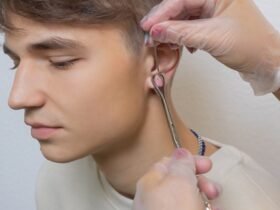A septum piercing is a trendy and stylish choice for those looking to add a unique element to their appearance. A common question among those considering this piercing is, “How long does it take a septum piercing to heal?” Typically, a septum piercing takes about 6 to 8 weeks to heal fully. Understanding the healing timeline and the necessary aftercare is crucial for a smooth recovery.
What is Septum Piercing?
A septum piercing is a type of body piercing that passes through the thin wall of cartilage (the septum) that separates the nostrils. It is favored for its distinctive look and the variety of jewelry styles that can be worn, from simple rings to ornate pieces.
In this article, we will explore the factors that influence the healing time of a septum piercing and provide detailed aftercare instructions. By understanding these aspects, you can ensure a successful and smooth healing process for your septum piercing.
Types of Septum Piercing
While the septum piercing itself is a singular type of piercing, there are variations and different styles that can be considered under this category based on the location, technique, and jewelry used. Here are the different types and styles associated with septum piercings:
1. Standard Septum Piercing
- Description: The most common form of septum piercing, placed through the thin tissue (columella) just below the nasal cartilage.
- Jewelry Options: Captive bead rings, circular barbells, horseshoe rings.
2. Septum Tusk
- Description: Involves wearing a larger, often straight piece of jewelry that mimics the look of animal tusks.
- Jewelry Options: Straight barbells, curved tusk-shaped jewelry.
3. Septum Clicker
- Description: Named for the clicker mechanism that allows for easy insertion and removal. Often more decorative with elaborate designs.
- Jewelry Options: Clicker rings with intricate designs, gemstones, or patterns.
4. Stretched Septum Piercing
- Description: A septum piercing that has been gradually stretched to accommodate larger gauge jewelry.
- Jewelry Options: Larger gauge rings, plugs, and tunnels.
5. Retainer Septum Piercing
- Description: A septum piercing where the jewelry is designed to be discreet and can be flipped up inside the nose to hide it.
- Jewelry Options: Septum retainers made of materials like glass, silicone, or metal.
6. Faux Septum Piercing
- Description: A non-permanent, clip-on type of jewelry that mimics the look of a septum piercing without actually piercing the skin.
- Jewelry Options: Clip-on rings and decorative faux septum jewelry.
7. Decorative and Ornate Septum Piercings
- Description: Uses highly decorative and intricate jewelry, often custom-made or featuring unique designs.
- Jewelry Options: Custom-designed pieces, jewelry with gemstones, elaborate patterns.
These different types and styles offer a range of aesthetic options for those considering or currently sporting a septum piercing, allowing for personal expression and customization.
Why Get a Septum Piercing?
A septum piercing is a unique and versatile type of body modification that appeals to a wide range of individuals for various reasons. Here are some of the main reasons why people choose to get a septum piercing:
1. Aesthetic Appeal
- Unique Look: A septum piercing stands out due to its central placement and can complement various facial features.
- Versatility: With a variety of jewelry options, from simple rings to ornate clickers, individuals can personalize their look to suit their style.
2. Cultural and Historical Significance
- Traditional Practices: Septum piercings have been part of various cultures for centuries, symbolizing different rites of passage, status, or heritage.
- Modern Revival: Influences from traditional practices have helped revive the popularity of septum piercings in contemporary fashion and culture.
Septum piercings hold significant cultural and historical importance across various societies. Among the Aztecs and Mayans, they symbolized bravery and high status among warriors. In rural India, women adorn themselves with large septum rings, known as “bulak,” as a part of their traditional attire. In West Africa, particularly among the Fulani tribe, septum piercings are regarded as symbols of beauty and wealth. Papua New Guinea tribes use septum piercings in ceremonial practices to signify rites of passage, while in modern times, punk and alternative subcultures have embraced them as symbols of rebellion and non-conformity. Through these examples, septum piercings reflect diverse cultural expressions and societal roles throughout history.
3. Self-Expression
- Personal Statement: Getting a septum piercing can be a powerful form of self-expression, allowing individuals to showcase their unique personality and style.
- Subculture Identification: Many subcultures, including punk, goth, and alternative communities, embrace septum piercings as part of their identity.
4. Discreet Option
- Easy to Hide: A septum piercing can be easily hidden by flipping the jewelry inside the nostrils, making it a discreet choice for those who may need to conceal their piercing for professional or personal reasons.
5. Low Maintenance
- Healing and Care: Septum piercings typically have a straightforward healing process and are less prone to infections compared to other facial piercings.
- Durability: Once healed, septum piercings require minimal maintenance and can accommodate various types of jewelry with ease.
6. Popularity and Trend
- Celebrity Influence: Many celebrities and influencers sport septum piercings, increasing their visibility and popularity in mainstream fashion.
- Fashion Statement: Septum piercings have become a trendy accessory, often featured in fashion magazines and runway shows.
7. Minimal Pain
- Pain Level: Many people find that getting a septum piercing is relatively painless compared to other types of body piercings, as it goes through a thin piece of tissue rather than cartilage.
8. Reversible
- Non-Permanent: If an individual decides they no longer want their septum piercing, it can be removed and, in most cases, will heal without significant scarring.
A septum piercing offers a blend of cultural depth, aesthetic versatility, and personal expression, making it an appealing choice for many individuals looking to enhance their appearance or make a statement.
Precaution for septum piercing
Taking precautions after getting a septum piercing is essential to ensure proper healing and minimize the risk of complications. Here are some important precautions to follow:
- Avoid Touching: Refrain from touching the piercing unnecessarily to prevent introducing bacteria and causing irritation.
- Keep It Clean: Clean the pierced area twice daily with saline solution or a gentle, fragrance-free soap to prevent infection.
- Avoid Harsh Products: Avoid using harsh skincare products, makeup, or alcohol-based cleansers on or around the piercing site.
- Be Mindful of Activities: Be cautious of activities that may put pressure or strain on the piercing, such as wearing tight clothing or sleeping on the face.
- Stay Hygienic: Maintain good overall hygiene, including washing your hands before touching the piercing or handling jewelry.
- Avoid Swimming: Refrain from swimming in pools, hot tubs, or natural bodies of water during the initial healing period to prevent exposure to bacteria.
- Watch for Signs of Infection: Keep an eye out for signs of infection, such as increased redness, swelling, pain, or discharge, and seek medical attention if necessary.
Following these precautions can help promote proper healing and reduce the risk of complications during the recovery process after a septum piercing.
How long does it take a septum piercing to heal?
The healing process for a septum piercing is a crucial aspect of ensuring its long-term success. Here are some key points regarding the healing timeline of a septum piercing:
- Typical Healing Time: Septum piercings usually take approximately 6 to 8 weeks to heal fully.
- Individual Variations: Healing time can vary based on factors such as individual healing capacity, aftercare practices, and overall health.
- Stages of Healing: The healing process typically progresses through stages, starting with initial soreness and swelling, followed by a reduction in symptoms as healing progresses.
- Signs of Healing: Signs of healing include reduced tenderness, swelling, and discharge, as well as the formation of a stable fistula (tissue tunnel) around the jewelry.
- Aftercare Importance: Proper aftercare, including cleaning the piercing regularly with saline solution and avoiding irritants, is essential for promoting optimal healing and minimizing the risk of infection or complications.
- Patience is Key: It’s important to be patient during the healing process and avoid changing or removing jewelry prematurely, as this can disrupt healing and increase the risk of complications.
Following these guidelines and being attentive to the body’s signals can help ensure a smooth and successful healing journey for a septum piercing.
Aftercare and Maintenance for septum piercing
Proper aftercare and maintenance are essential for ensuring the successful healing of a septum piercing and preventing complications. Here are some important aftercare and maintenance guidelines to follow:
- Cleaning Routine: Clean the pierced area twice daily using saline solution or a gentle, fragrance-free soap and warm water.
- Gentle Handling: Handle the piercing with clean hands and avoid excessive touching or rotating of the jewelry to prevent irritation and disruption of healing.
- Avoid Irritants: Refrain from using harsh skincare products, makeup, or alcohol-based cleansers on or around the piercing site, as these can irritate the skin and delay healing.
- Protective Measures: Be mindful of activities that may put pressure or strain on the piercing, such as wearing tight clothing or sleeping on the face, and take steps to minimize contact with the piercing site.
- Avoid Swimming: Avoid swimming in pools, hot tubs, or natural bodies of water during the initial healing period to prevent exposure to bacteria.
- Regular Check-ups: Schedule regular check-ups with your piercer to monitor the healing progress and address any concerns or complications promptly.
- Stay Hydrated: Drink plenty of water to support overall healing and hydration, which can help promote healing of the piercing.
- Avoid Smoking and Alcohol: Smoking and alcohol consumption can impair healing and increase the risk of infection, so it’s best to avoid these substances during the healing period.
Following these aftercare and maintenance guidelines diligently can help promote optimal healing and reduce the risk of complications for a septum piercing.
Managing Complications
While septum piercings typically heal without complications when proper aftercare is followed, it’s essential to be aware of potential issues that may arise during the healing process. Here are some possible complications and what may happen if anything goes wrong with a septum piercing:
- Infection: If bacteria enter the piercing site, it can lead to infection, characterized by symptoms such as increased redness, swelling, pain, and discharge.
- Migration or Rejection: In some cases, the body may perceive the piercing as a foreign object and attempt to push it out, resulting in migration or rejection of the jewelry.
- Keloids or Hypertrophic Scarring: Excessive scarring may occur, leading to the formation of keloids or hypertrophic scars around the piercing site, particularly in individuals prone to scarring.
- Allergic Reactions: Some individuals may experience allergic reactions to the jewelry material, leading to symptoms such as itching, redness, and swelling.
- Nasal Septum Perforation: In rare cases, improper piercing technique or trauma to the septum may result in nasal septum perforation, a hole in the nasal septum that requires medical intervention to repair.
- Delayed Healing: Factors such as poor aftercare, underlying health conditions, or lifestyle habits may delay the healing process, prolonging discomfort and increasing the risk of complications.
- Pain and Discomfort: Persistent pain, discomfort, or sensitivity around the piercing site may indicate an issue that requires attention, such as infection or improper jewelry placement.
If any of these complications occur or if you experience any unusual symptoms during the healing process, it’s essential to seek prompt medical attention from a qualified healthcare professional or your piercer. Ignoring complications can lead to further issues and may compromise the healing of the septum piercing.
Septum Piercing Alternatives
While septum piercings are a popular choice for those seeking a unique and versatile form of body modification, there are alternative options available for individuals who may prefer different types of piercings or want to explore other options. Here are some alternatives to septum piercings:
- Nose Piercings: Instead of a septum piercing, some individuals opt for nostril piercings, where the jewelry is inserted through the nostril itself.
- Ear Piercings: Various ear piercings, such as helix piercings, tragus piercings, or cartilage piercings, offer alternative options for those interested in body modification.
- Lip Piercings: Lip piercings, including labret piercings, medusa piercings, or snake bites, provide a distinctive look that may appeal to individuals seeking facial piercings.
- Facial Piercings: Other facial piercings, such as eyebrow piercings, cheek piercings, or bridge piercings, offer alternative options for those interested in modifying their appearance.
- Temporary Jewelry: Temporary septum jewelry, such as faux septum rings or magnetic septum studs, allows individuals to experiment with the look of a septum piercing without committing to a permanent piercing.
- Non-Piercing Options: Some individuals may prefer non-piercing alternatives, such as septum cuffs or septum clickers that clip onto the septum without the need for a piercing.
- Tattoos: For those interested in body modification but not keen on piercings, septum tattoos or other forms of body art offer alternative ways to express individuality and creativity.
Exploring these alternatives allows individuals to find a body modification option that aligns with their preferences, style, and comfort level. Whether opting for a different type of piercing or exploring non-piercing options, there are various ways to achieve a unique and personalized look without a septum piercing.
Conclusion:
The healing process of a septum piercing is a crucial aspect of the overall piercing experience. While the typical healing time ranges from 6 to 8 weeks, individual factors such as aftercare practices, health, and lifestyle can influence the healing duration. It’s essential to follow proper aftercare instructions, stay vigilant for signs of healing or complications, and be patient throughout the process. By prioritizing care and patience, individuals can support the healing of their septum piercing and enjoy their new adornment safely and comfortably.












Got a Questions?
Find us on Socials or Contact us and we’ll get back to you as soon as possible.